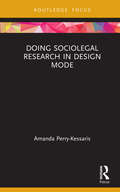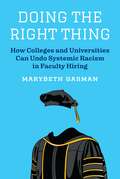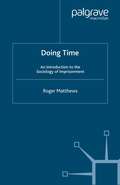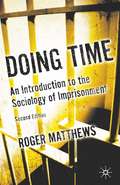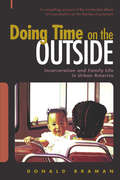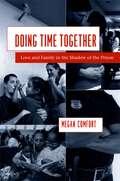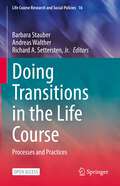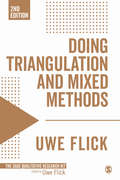- Table View
- List View
Doing Sociolegal Research in Design Mode
by Amanda Perry-KessarisThis book is the first to explore what design can do for sociolegal research. It argues that designerly ways—mindsets that are practical, critical and imaginative, experimental processes and visible and tangible communication strategies—can be combined to generate potentially enabling ecosystems; and that within these ecosystems the abilities of a researcher to make meaningful contributions and to engage in meaningful research relations, both within our research community and in the wider world, can be enhanced. It is grounded in richly illustrated examples of sociolegal researchers working in design mode, including original individual and collaborative experiments involving a total of over 200 researchers; and of experts from subfields such as social design, policy design, and speculative design working on issues of sociolegal concern. It closes with an opening: a set of accessible sociolegal design briefs on which the impatient can make an immediate start. Written by an experienced sociolegal researcher with formal training in graphic design, the book is primarily focused on what the sociolegal research community can take from design, but it also offers lessons to designers, especially those who work with law.
Doing Sociolegal Research in Design Mode
by Amanda Perry-KessarisThis book is the first to explore what design can do for sociolegal research. It argues that designerly ways—mindsets that are practical, critical and imaginative, experimental processes and visible and tangible communication strategies—can be combined to generate potentially enabling ecosystems; and that within these ecosystems the abilities of a researcher to make meaningful contributions and to engage in meaningful research relations, both within our research community and in the wider world, can be enhanced. It is grounded in richly illustrated examples of sociolegal researchers working in design mode, including original individual and collaborative experiments involving a total of over 200 researchers; and of experts from subfields such as social design, policy design, and speculative design working on issues of sociolegal concern. It closes with an opening: a set of accessible sociolegal design briefs on which the impatient can make an immediate start. Written by an experienced sociolegal researcher with formal training in graphic design, the book is primarily focused on what the sociolegal research community can take from design, but it also offers lessons to designers, especially those who work with law.
Doing Space while Doing Gender - Vernetzungen von Raum und Geschlecht in Forschung und Politik (Dynamiken von Raum und Geschlecht #4)
by Rebekka HabermasJeder Ort, jeder Körper steht in Verbindung zu anderen und wird erst in diesem Gefüge von Relationen zu sich selbst. Dieser Band entwirft Fluchtlinien im Doing Space while Doing Gender. In einem ersten Buchteil stellen Beiträge zentrale Begriffe wie »Exposure«, »Materialität« oder »Transsektionalität« vor. Ein zweiter Buchteil versammelt Studien - etwa zum Heiratsmarkt Ende des 19. Jahrhunderts, zu queeren Körpern in New York oder der Lyrik Gloria Fuertes'. Durch die inhaltliche Verlinkung der Beiträge ist der Band auch als Handbuch nutzbar, soll zur Diskussion einladen und zeigt an vielen Stellen, dass Dynamiken von Raum und Geschlecht nicht zuletzt politische Fragen der Gegenwart betreffen.
Doing Statistical Analysis: A Student’s Guide to Quantitative Research
by Christer ThraneDoing Statistical Analysis looks at three kinds of statistical research questions – descriptive, associational, and inferential – and shows students how to conduct statistical analyses and interpret the results. Keeping equations to a minimum, it uses a conversational style and relatable examples such as football, COVID-19, and tourism, to aid understanding. Each chapter contains practice exercises, and a section showing students how to reproduce the statistical results in the book using Stata and SPSS. Digital supplements consist of data sets in Stata, SPSS, and Excel, and a test bank for instructors. Its accessible approach means this is the ideal textbook for undergraduate students across the social and behavioral sciences needing to build their confidence with statistical analysis.
Doing Statistical Analysis: A Student’s Guide to Quantitative Research
by Christer ThraneDoing Statistical Analysis looks at three kinds of statistical research questions – descriptive, associational, and inferential – and shows students how to conduct statistical analyses and interpret the results. Keeping equations to a minimum, it uses a conversational style and relatable examples such as football, COVID-19, and tourism, to aid understanding. Each chapter contains practice exercises, and a section showing students how to reproduce the statistical results in the book using Stata and SPSS. Digital supplements consist of data sets in Stata, SPSS, and Excel, and a test bank for instructors. Its accessible approach means this is the ideal textbook for undergraduate students across the social and behavioral sciences needing to build their confidence with statistical analysis.
Doing Statistics With SPSS
by Dr Stephen A Kozub Mr Alistair W Kerr Professor Howard K Hall`This book is to be commended, particularly, for putting the tool of statistics into the familiar context of a research study. In so doing it emphasizes the neglected pre-analysis stages of a research study. Indeed the performing of a data analysis, this book reminds us, should be the mere icing on an already well cooked cake' - Psychology Learning & Teaching Doing Statistics With SPSS is derived from the authors' many years of experience teaching undergraduates data handling using SPSS. It assumes no prior understanding beyond that of basic mathematical operations and is therefore suitable for anyone undertaking an introductory statistics course as part of a science based undergraduate programme. The text will: enable the reader to make informed choices about what statistical tests to employ; what assumptions are made in using a particular test; demonstrate how to execute the analysis using SPSS; and guide the reader in his/her interpretation of its output. Each chapter ends with an exercise and provides detailed instructions on how to run the analysis using SPSS release 10. Learning is further guided by pointing the reader to particular aspects of the SPSS output and by having the reader engage with specified items of information from the SPSS results. This text is more complete than the alternatives that usually fall into one of two camps. They either provide an explanation of the concepts but no instructions on how to execute the analysis with SPSS, or they are a manual which instructs the reader on how to drive the software but with minimal explanation of what it all means. This book offers the best elements of both in a style that is economical and accessible. Doing Statistics with SPSS will be essential reading for undergraduates in psychology and health-related disciplines, and likely to be of invaluable use to many other students in the social sciences taking a course in statistics.
Doing Statistics With SPSS (PDF)
by Dr Stephen A Kozub Mr Alistair W Kerr Professor Howard K Hall`This book is to be commended, particularly, for putting the tool of statistics into the familiar context of a research study. In so doing it emphasizes the neglected pre-analysis stages of a research study. Indeed the performing of a data analysis, this book reminds us, should be the mere icing on an already well cooked cake' - Psychology Learning & Teaching Doing Statistics With SPSS is derived from the authors' many years of experience teaching undergraduates data handling using SPSS. It assumes no prior understanding beyond that of basic mathematical operations and is therefore suitable for anyone undertaking an introductory statistics course as part of a science based undergraduate programme. The text will: enable the reader to make informed choices about what statistical tests to employ; what assumptions are made in using a particular test; demonstrate how to execute the analysis using SPSS; and guide the reader in his/her interpretation of its output. Each chapter ends with an exercise and provides detailed instructions on how to run the analysis using SPSS release 10. Learning is further guided by pointing the reader to particular aspects of the SPSS output and by having the reader engage with specified items of information from the SPSS results. This text is more complete than the alternatives that usually fall into one of two camps. They either provide an explanation of the concepts but no instructions on how to execute the analysis with SPSS, or they are a manual which instructs the reader on how to drive the software but with minimal explanation of what it all means. This book offers the best elements of both in a style that is economical and accessible. Doing Statistics with SPSS will be essential reading for undergraduates in psychology and health-related disciplines, and likely to be of invaluable use to many other students in the social sciences taking a course in statistics.
Doing Style: Youth and Mass Mediation in South India
by Constantine V. NakassisIn Doing Style, Constantine V. Nakassis explores the world of youth and mass media in South India, where what Tamil youth call “style” anchors their day-to-day lives and media worlds. Through intimate ethnographic descriptions of college life in Tamil Nadu, Nakassis explores the complex ways that acts and objects of style such as brand fashion, English slang, and film representations express the multiple desires and anxieties of this generation, who live in the shadow of the promise of global modernity. As Nakassis shows, while signs of the global, modern world are everywhere in post-liberalization India, for most of these young people this world is still very distant—a paradox that results in youth’s profound sense of being in between. This in-betweenness manifests itself in the ambivalent quality of style, the ways in which stylish objects are necessarily marked as counterfeit, mixed, or ironical. In order to show how this in-betweenness materializes in particular media, Nakassis explores the entanglements between youth peer groups and the sites where such stylish media objects are produced, arguing that these entanglements deeply condition the production and circulation of the media objects themselves. The result is an important and timely look at the tremendous forces of youth culture, globalization, and mass media as they interact in the vibrancy of a rapidly changing India.
Doing Style: Youth and Mass Mediation in South India
by Constantine V. NakassisIn Doing Style, Constantine V. Nakassis explores the world of youth and mass media in South India, where what Tamil youth call “style” anchors their day-to-day lives and media worlds. Through intimate ethnographic descriptions of college life in Tamil Nadu, Nakassis explores the complex ways that acts and objects of style such as brand fashion, English slang, and film representations express the multiple desires and anxieties of this generation, who live in the shadow of the promise of global modernity. As Nakassis shows, while signs of the global, modern world are everywhere in post-liberalization India, for most of these young people this world is still very distant—a paradox that results in youth’s profound sense of being in between. This in-betweenness manifests itself in the ambivalent quality of style, the ways in which stylish objects are necessarily marked as counterfeit, mixed, or ironical. In order to show how this in-betweenness materializes in particular media, Nakassis explores the entanglements between youth peer groups and the sites where such stylish media objects are produced, arguing that these entanglements deeply condition the production and circulation of the media objects themselves. The result is an important and timely look at the tremendous forces of youth culture, globalization, and mass media as they interact in the vibrancy of a rapidly changing India.
Doing Style: Youth and Mass Mediation in South India
by Constantine V. NakassisIn Doing Style, Constantine V. Nakassis explores the world of youth and mass media in South India, where what Tamil youth call “style” anchors their day-to-day lives and media worlds. Through intimate ethnographic descriptions of college life in Tamil Nadu, Nakassis explores the complex ways that acts and objects of style such as brand fashion, English slang, and film representations express the multiple desires and anxieties of this generation, who live in the shadow of the promise of global modernity. As Nakassis shows, while signs of the global, modern world are everywhere in post-liberalization India, for most of these young people this world is still very distant—a paradox that results in youth’s profound sense of being in between. This in-betweenness manifests itself in the ambivalent quality of style, the ways in which stylish objects are necessarily marked as counterfeit, mixed, or ironical. In order to show how this in-betweenness materializes in particular media, Nakassis explores the entanglements between youth peer groups and the sites where such stylish media objects are produced, arguing that these entanglements deeply condition the production and circulation of the media objects themselves. The result is an important and timely look at the tremendous forces of youth culture, globalization, and mass media as they interact in the vibrancy of a rapidly changing India.
Doing Style: Youth and Mass Mediation in South India
by Constantine V. NakassisIn Doing Style, Constantine V. Nakassis explores the world of youth and mass media in South India, where what Tamil youth call “style” anchors their day-to-day lives and media worlds. Through intimate ethnographic descriptions of college life in Tamil Nadu, Nakassis explores the complex ways that acts and objects of style such as brand fashion, English slang, and film representations express the multiple desires and anxieties of this generation, who live in the shadow of the promise of global modernity. As Nakassis shows, while signs of the global, modern world are everywhere in post-liberalization India, for most of these young people this world is still very distant—a paradox that results in youth’s profound sense of being in between. This in-betweenness manifests itself in the ambivalent quality of style, the ways in which stylish objects are necessarily marked as counterfeit, mixed, or ironical. In order to show how this in-betweenness materializes in particular media, Nakassis explores the entanglements between youth peer groups and the sites where such stylish media objects are produced, arguing that these entanglements deeply condition the production and circulation of the media objects themselves. The result is an important and timely look at the tremendous forces of youth culture, globalization, and mass media as they interact in the vibrancy of a rapidly changing India.
Doing Style: Youth and Mass Mediation in South India
by Constantine V. NakassisIn Doing Style, Constantine V. Nakassis explores the world of youth and mass media in South India, where what Tamil youth call “style” anchors their day-to-day lives and media worlds. Through intimate ethnographic descriptions of college life in Tamil Nadu, Nakassis explores the complex ways that acts and objects of style such as brand fashion, English slang, and film representations express the multiple desires and anxieties of this generation, who live in the shadow of the promise of global modernity. As Nakassis shows, while signs of the global, modern world are everywhere in post-liberalization India, for most of these young people this world is still very distant—a paradox that results in youth’s profound sense of being in between. This in-betweenness manifests itself in the ambivalent quality of style, the ways in which stylish objects are necessarily marked as counterfeit, mixed, or ironical. In order to show how this in-betweenness materializes in particular media, Nakassis explores the entanglements between youth peer groups and the sites where such stylish media objects are produced, arguing that these entanglements deeply condition the production and circulation of the media objects themselves. The result is an important and timely look at the tremendous forces of youth culture, globalization, and mass media as they interact in the vibrancy of a rapidly changing India.
Doing Style: Youth and Mass Mediation in South India
by Constantine V. NakassisIn Doing Style, Constantine V. Nakassis explores the world of youth and mass media in South India, where what Tamil youth call “style” anchors their day-to-day lives and media worlds. Through intimate ethnographic descriptions of college life in Tamil Nadu, Nakassis explores the complex ways that acts and objects of style such as brand fashion, English slang, and film representations express the multiple desires and anxieties of this generation, who live in the shadow of the promise of global modernity. As Nakassis shows, while signs of the global, modern world are everywhere in post-liberalization India, for most of these young people this world is still very distant—a paradox that results in youth’s profound sense of being in between. This in-betweenness manifests itself in the ambivalent quality of style, the ways in which stylish objects are necessarily marked as counterfeit, mixed, or ironical. In order to show how this in-betweenness materializes in particular media, Nakassis explores the entanglements between youth peer groups and the sites where such stylish media objects are produced, arguing that these entanglements deeply condition the production and circulation of the media objects themselves. The result is an important and timely look at the tremendous forces of youth culture, globalization, and mass media as they interact in the vibrancy of a rapidly changing India.
Doing Surveys Online
by Dr Vera ToepoelLecturers, request your electronic inspection copy Vera Toepoel’s practical, how-to guide to doing surveys online takes you through the entire process of using surveys, from systematically recruiting respondents, to designing the internet survey, to processing the survey data and writing it up. This book helps students and researchers in identifying possible strategies to make the best use of online surveys, providing pro’s and con’s, and do’s and don’ts for each strategy. It also explores the latest opportunities and developments that have arisen in the field of online surveys, including using social networks, and provides expert guidance and examples of best practice throughout. Suitable for those starting a research project or conducting a survey in a professional capacity, this book is the ideal go-to reference for anyone using internet surveys, be it a beginner or a more experienced survey researcher.
Doing Surveys Online (PDF)
by Dr Vera ToepoelLecturers, request your electronic inspection copy Vera Toepoel’s practical, how-to guide to doing surveys online takes you through the entire process of using surveys, from systematically recruiting respondents, to designing the internet survey, to processing the survey data and writing it up. This book helps students and researchers in identifying possible strategies to make the best use of online surveys, providing pro’s and con’s, and do’s and don’ts for each strategy. It also explores the latest opportunities and developments that have arisen in the field of online surveys, including using social networks, and provides expert guidance and examples of best practice throughout. Suitable for those starting a research project or conducting a survey in a professional capacity, this book is the ideal go-to reference for anyone using internet surveys, be it a beginner or a more experienced survey researcher.
Doing the Right Thing: How Colleges and Universities Can Undo Systemic Racism in Faculty Hiring
by Marybeth GasmanAn honest confrontation of systemic racism in faculty hiring—and what to do about itWhile colleges and universities have been lauded for increasing student diversity, these same institutions have failed to achieve any comparable diversity among their faculty. In 2017, of the nation’s full-time, tenure-track and tenured faculty, only 3 percent each were Black men, Black women, Hispanic men, and Hispanic women. Only 6 percent were Asian/Pacific Islander men, 5 percent were Asian/Pacific Islander women, and 1 percent were American Indian/Alaska Native. Why are the numbers so abysmal? In Doing the Right Thing, Marybeth Gasman takes a hard, insightful look at the issues surrounding the recruitment and hiring of faculty of color. Relying on national data and interviews with provosts, deans, and department chairs from sixty major universities, Gasman documents the institutional forces stymieing faculty diversification, and she makes the case for how such deficiencies can and should be rectified.Even as institutions publicly champion inclusive excellence and the number of doctoral students of color increases, Gasman reveals the entrenched constraints contributing to the faculty status quo. Impediments to progress include the alleged trade-off between quality and diversity, the power of pedigree, the rigidity of academic pipelines, failures of administrative leadership, lack of accountability among administration and faculty, and the opacity and arbitrariness of the recruitment and hiring process. Gasman contends that leaders must acknowledge institutional failures of inclusion, pervasive systemic racism, and biases that restrict people of color from pursuing faculty careers.Recognizing that individuals from all backgrounds are essential to the creation and teaching of knowledge, Doing the Right Thing puts forth a concrete call for colleges and universities to take action and do better.
Doing Time: An Introduction to the Sociology of Imprisonment
by R. MatthewsThis book is designed to acquaint students with some of the main issues associated with the emergence and development of the modern prison. It draws on a range of sociological theorising in order to analyse the organisation and the functioning of the prison. It examines the conditions for the expansion of the prison and explores the possibilities for limiting prison use through the development of alternatives to custody. In particular, it looks in some detail at the relation between imprisonment and class, age, gender and race.
Doing Time: An Introduction to the Sociology of Imprisonment
by Roger MatthewsThe new edition of Doing Time brings this widely recognized book up-to-date and provides an accessible and informed discussion of current debates around prisons and penal policy. Drawing on a range of international material the book provides a critical sociological analysis of developments in imprisonment.
Doing Time on the Outside: Incarceration and Family Life in Urban America
by Donald Braman"Stigma, shame and hardship---this is the lot shared by families whose young men have been swept into prison. Braman reveals the devastating toll mass incarceration takes on the parents, partners, and children left behind." -Katherine S. Newman "Doing Time on the Outside brings to life in a compelling way the human drama, and tragedy, of our incarceration policies. Donald Braman documents the profound economic and social consequences of the American policy of massive imprisonment of young African American males. He shows us the link between the broad-scale policy changes of recent decades and the isolation and stigma that these bring to family members who have a loved one in prison. If we want to understand fully the impact of current criminal justice policies, this book should be required reading." -Mark Mauer, Assistant Director, The Sentencing Project "Through compelling stories and thoughtful analysis, this book describes how our nation's punishment policies have caused incalculable damage to the fabric of family and community life. Anyone concerned about the future of urban America should read this book." -Jeremy Travis, The Urban Institute In the tradition of Elijah Anderson's Code of the Street and Katherine Newman's No Shame in My Game, this startling new ethnography by Donald Braman uncovers the other side of the incarceration saga: the little-told story of the effects of imprisonment on the prisoners' families. Since 1970 the incarceration rate in the United States has more than tripled, and in many cities-urban centers such as Washington, D.C.-it has increased over five-fold. Today, one out of every ten adult black men in the District is in prison and three out of every four can expect to spend some time behind bars. But the numbers don't reveal what it's like for the children, wives, and parents of prisoners, or the subtle and not-so-subtle effects mass incarceration is having on life in the inner city. Author Donald Braman shows that those doing time on the inside are having a ripple effect on the outside-reaching deep into the family and community life of urban America. Braman gives us the personal stories of what happens to the families and communities that prisoners are taken from and return to. Carefully documenting the effects of incarceration on the material and emotional lives of families, this groundbreaking ethnography reveals how criminal justice policies are furthering rather than abating the problem of social disorder. Braman also delivers a number of genuinely new arguments. Among these is the compelling assertion that incarceration is holding offenders unaccountable to victims, communities, and families. The author gives the first detailed account of incarceration's corrosive effect on social capital in the inner city and describes in poignant detail how the stigma of prison pits family and community members against one another. Drawing on a series of powerful family portraits supported by extensive empirical data, Braman shines a light on the darker side of a system that is failing the very families and communities it seeks to protect.
Doing Time Together: Love and Family in the Shadow of the Prison
by Megan ComfortBy quadrupling the number of people behind bars in two decades, the United States has become the world leader in incarceration. Much has been written on the men who make up the vast majority of the nation’s two million inmates. But what of the women they leave behind? Doing Time Together vividly details the ways that prisons shape and infiltrate the lives of women with husbands, fiancés, and boyfriends on the inside. Megan Comfort spent years getting to know women visiting men at San Quentin State Prison, observing how their romantic relationships drew them into contact with the penitentiary. Tangling with the prison’s intrusive scrutiny and rigid rules turns these women into “quasi-inmates,” eroding the boundary between home and prison and altering their sense of intimacy, love, and justice. Yet Comfort also finds that with social welfare weakened, prisons are the most powerful public institutions available to women struggling to overcome untreated social ills and sustain relationships with marginalized men. As a result, they express great ambivalence about the prison and the control it exerts over their daily lives. An illuminating analysis of women caught in the shadow of America’s massive prison system, Comfort’s book will be essential for anyone concerned with the consequences of our punitive culture.
Doing Time Together: Love and Family in the Shadow of the Prison
by Megan ComfortBy quadrupling the number of people behind bars in two decades, the United States has become the world leader in incarceration. Much has been written on the men who make up the vast majority of the nation’s two million inmates. But what of the women they leave behind? Doing Time Together vividly details the ways that prisons shape and infiltrate the lives of women with husbands, fiancés, and boyfriends on the inside. Megan Comfort spent years getting to know women visiting men at San Quentin State Prison, observing how their romantic relationships drew them into contact with the penitentiary. Tangling with the prison’s intrusive scrutiny and rigid rules turns these women into “quasi-inmates,” eroding the boundary between home and prison and altering their sense of intimacy, love, and justice. Yet Comfort also finds that with social welfare weakened, prisons are the most powerful public institutions available to women struggling to overcome untreated social ills and sustain relationships with marginalized men. As a result, they express great ambivalence about the prison and the control it exerts over their daily lives. An illuminating analysis of women caught in the shadow of America’s massive prison system, Comfort’s book will be essential for anyone concerned with the consequences of our punitive culture.
Doing Time Together: Love and Family in the Shadow of the Prison
by Megan ComfortBy quadrupling the number of people behind bars in two decades, the United States has become the world leader in incarceration. Much has been written on the men who make up the vast majority of the nation’s two million inmates. But what of the women they leave behind? Doing Time Together vividly details the ways that prisons shape and infiltrate the lives of women with husbands, fiancés, and boyfriends on the inside. Megan Comfort spent years getting to know women visiting men at San Quentin State Prison, observing how their romantic relationships drew them into contact with the penitentiary. Tangling with the prison’s intrusive scrutiny and rigid rules turns these women into “quasi-inmates,” eroding the boundary between home and prison and altering their sense of intimacy, love, and justice. Yet Comfort also finds that with social welfare weakened, prisons are the most powerful public institutions available to women struggling to overcome untreated social ills and sustain relationships with marginalized men. As a result, they express great ambivalence about the prison and the control it exerts over their daily lives. An illuminating analysis of women caught in the shadow of America’s massive prison system, Comfort’s book will be essential for anyone concerned with the consequences of our punitive culture.
Doing Transitions in the Life Course: Processes and Practices (Life Course Research and Social Policies #16)
by Barbara Stauber Andreas Walther Richard A. SetterstenThis open access book provides a unique research perspective on life course transitions. Here, transitions are understood as social processes and practices. Leveraging the recent “practice turn” in the social sciences, the contributors analyze how life course transitions are “done.” This book introduces the concept of “doing transitions” and its implications for theories and methods. It presents fresh empirical research on “doing transitions” in different life phases (e.g., childhood, young adulthood, later life) and life domains (e.g., education, work, family, health, migration). It also emphasizes themes related to institutions and organizations, time and normativity, materialities (such as bodies, spaces, and artifacts), and the reproduction of social inequalities in education and welfare. In coupling this new perspective with empirical illustrations, this book is an indispensable resource for scholars from demography, sociology, psychology, social work and other scientific fields, as well as for students, counselors and practitioners, and policymakers.
Doing Triangulation and Mixed Methods (Qualitative Research Kit #8)
by Dr Uwe FlickThis book shows you not just how to use triangulation as a strategy of quality management, but also how to use it as an approach to designing and doing qualitative research in a more comprehensive way. Flick links triangulation with current debates about using mixed methods, and outlines their potential for extending qualitative research, addressing questions such as how such research can benefit from integrating quantitative (mixed methods), or from working more generally with more than one approach (triangulation).
Doing Triangulation and Mixed Methods (Qualitative Research Kit #8)
by Dr Uwe FlickThis book shows you not just how to use triangulation as a strategy of quality management, but also how to use it as an approach to designing and doing qualitative research in a more comprehensive way. Flick links triangulation with current debates about using mixed methods, and outlines their potential for extending qualitative research, addressing questions such as how such research can benefit from integrating quantitative (mixed methods), or from working more generally with more than one approach (triangulation).
